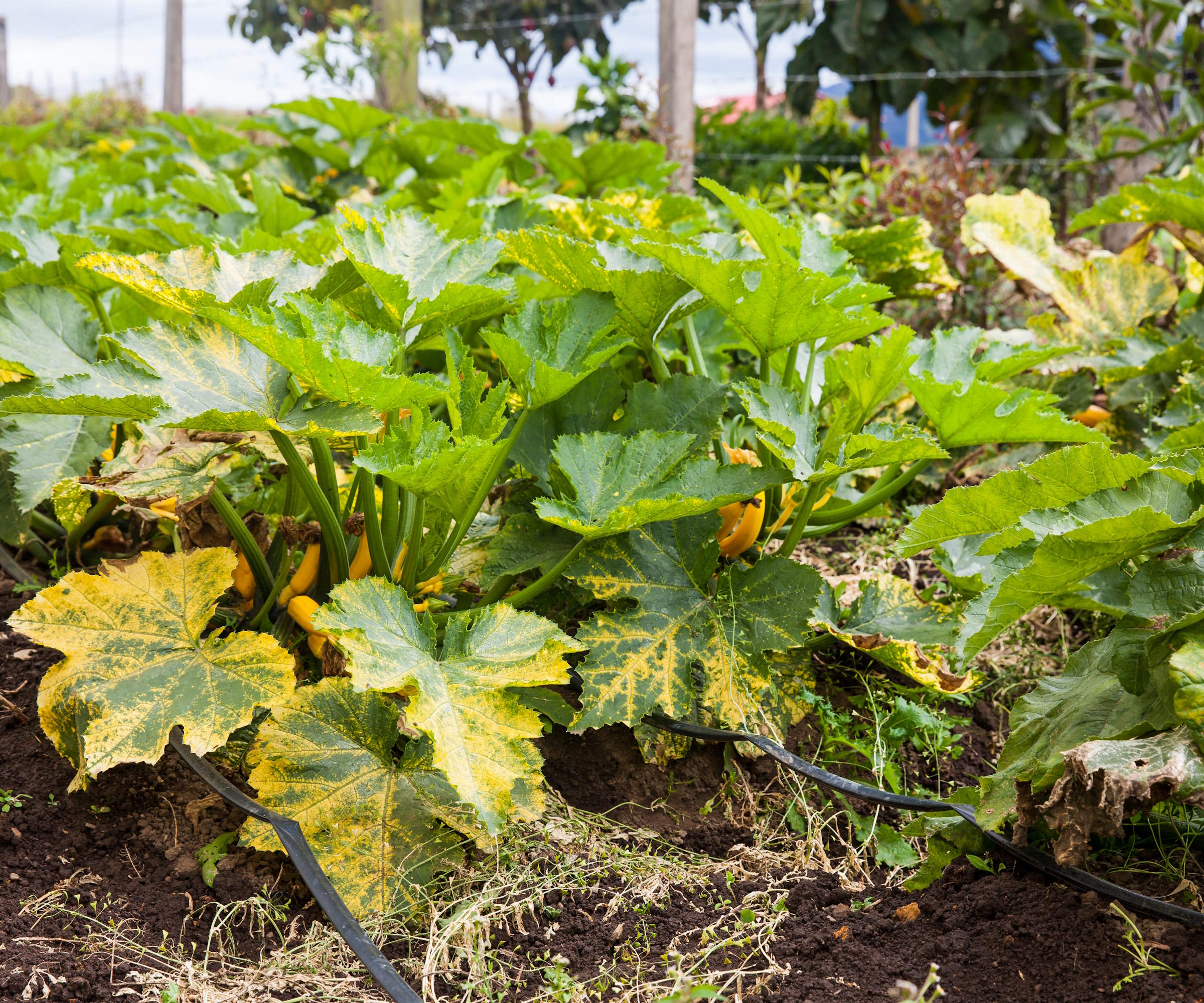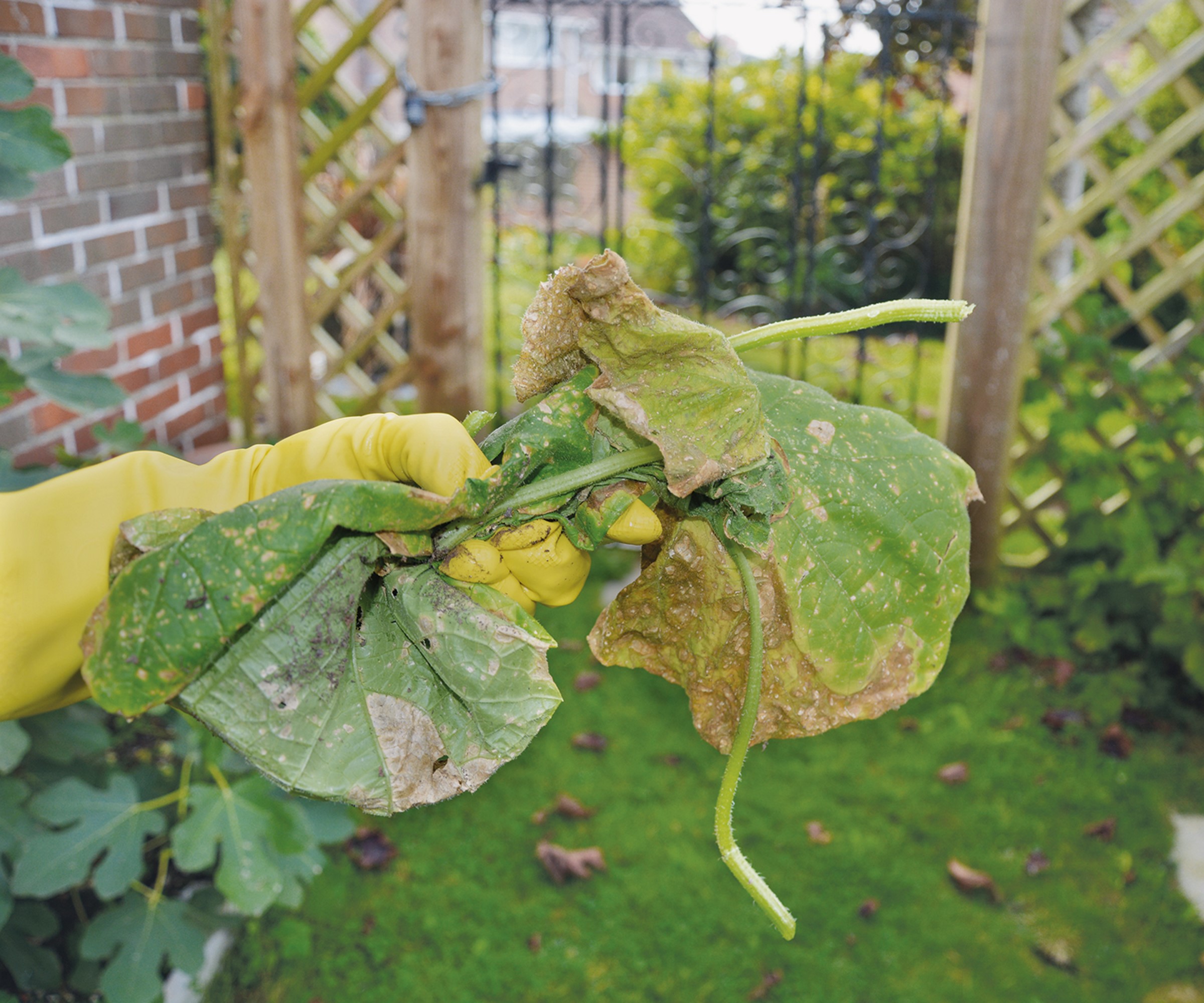Why is my zucchini plant turning yellow? 4 common issues and how to fix them
Are your plants discolored? Diagnose and treat your ailing zucchini plants with our expert tips


Zucchini are very easy to grow and more often than not produce a large harvest of fruits each year. Problems can arise and you may see the plants turning yellow, so what can cause that and how worrying is it?
If you spot discolored foliage when growing zucchini it may cause you to wonder, why are my zucchini plants turning yellow? In truth, there are a few usual suspects that cause foliage to turn yellow, namely nutrients, watering, pests, and disease.
To help you identify, and hopefully rectify issues with a zucchini plant turning yellow, let's take a closer look at each, what may cause it, and what you can do to combat the problem in your vegetable garden.

Zucchini plants with yellow foliage is not an unusual sight
4 reasons the leaves on zucchini plants turn yellow
Yellowing leaves can be a sign of the plant naturally ageing, though it may also be an indicator of more worrying issues.
If you spot discolored foliage when out and about in your kitchen garden, then a closer examination may be required to get to the root of the problem. Acting quickly can help turn around a plant’s fortunes and mean you still get a great zucchini harvest.
1. Lack of nutrients

A zucchini lacking in nutrients can turn yellow and struggle to produce fruits
Zucchini plants are heavy feeders and need a lot of nutrients as they grow and develop their large foliage and fruits. Yellowing leaves can be a sign of poor nutrition, caused by a lack of nutrients in the soil. If a zucchini lacks enough nutrients, the foliage will be yellow and any fruits it produces will be smaller.
It may be a lack of nitrogen, iron, or manganese which causes the leaves to yellow. A soil test can show if your soil type lacks certain nutrients and any deficiencies can be treated with fertilizer or with the addition of compost to the planting site.
Design expertise in your inbox – from inspiring decorating ideas and beautiful celebrity homes to practical gardening advice and shopping round-ups.
The ideal feeding regime for the crop is to add a balanced slow-release fertilizer when you plant zucchini and then use a feed designed for growing vegetables when the plants start blooming.
2. Watering issues

Soaking the foliage when watering can cause zucchini plants to turn yellow
Watering can cause many issues, including yellow foliage, and, without confusing matters too much, both overwatering and underwatering may be responsible for this issue.
A lack of water will stress the plant and cause the foliage to turn yellow as it struggles to provide the foliage with the nutrients it needs to thrive. Zucchini want two inches of water per week, so keep a close eye on when to water plants. A soil moisture meter, available at Amazon, can be a quick and simple tool to show you exactly when zucchini plants need watering.
Overwatering plants can cause too much moisture to sit in the soil and it means the roots can be deprived of oxygen. This suffocation of the roots will lead to the foliage discoloring and plants wilting. Lindsey Chastain, homesteader and founder of The Waddle and Cluck, claims: ‘To find out if the plant has been overwatered, stick your finger down into the soil as far as you can. The soil should feel moist, but not wet.’
Planting zucchini in well-draining soil is essential to avoid the plant sitting in soggy ground - if you have heavy soil adding organic matter will boost the drainage. If you are growing zucchini in a container, drainage holes in the bottom of the planter are essential to allow excess moisture to drain away.
If you fear overwatering may be the cause, there are ways to fix an overwatered plant. The easiest is to stop watering the plant and keep a close eye on what happens to the color and health of the plant as the soil dries out.

Lindsey Chastain is the founder of The Waddle and Cluck, a website about all things homesteading from livestock to gardening to recipes.
3. Pest problems

Aphids suck sap from zucchini and can turn leaves yellow
Pests are always a problem in a vegetable garden and there is a list of nasties that could be damaging your plant and causing it to turn yellow.
That includes spider mites and aphids, which both suck sap from the plants as they arrive en masse and feast on foliage and stems. To get rid of aphids and spider mites, you can use insecticidal soap or neem oil and even simply dislodge the pests from plants with a jet of water.
John Coykendall, the master gardener at Blackberry Farm, has another troublesome zucchini pest to add to the list. He claims: ‘Squash beetles and squash bugs are known to cause yellowing. They’re gray in color and about an inch long.’
Squash bugs lay eggs on the underside of leaves. The pests can be picked off by hand and put in a container filled with water and dish soap, or sprayed with insecticidal soap. Companion planting zucchini with nasturtiums or calendula can also help repel these troublesome zucchini pests.

John Coykendall is the Master Gardener at Blackberry Farm, a 4,200-acre, land-focused resort in East Tennessee. A walking encyclopedia of gardening knowledge, John is a world renowned expert in seed saving and author of 'Preserving Our Roots: My Journey to Save Seeds and Stories' available at Amazon.
4. Disease

Yellow and diseased zucchini leaves should be removed and disposed of
Some zucchini diseases can strike plants and cause leaves to turn yellow and wilt. This includes fungal diseases.
Overhead watering and wet summers can cause fungal problems, so avoid making watering mistakes and use drip irrigation to keep moisture off leaves - or simply make sure you soak the base of the plants if watering by hand. If you spot the signs of fungal diseases, the issue can be treated with fungicides.
Teneya Parks, an urban farmer at Farmscape, explains: ‘Powdery mildew, a common fungal infection, starts as white powdery spots on leaves and stems, eventually causing yellowing and leaf drop.
‘Other diseases, such as cucumber mosaic virus (transmitted by aphids) and Fusarium wilt (a fungal disease), can also cause yellow leaves and stunted growth.’
Mosaic virus is more serious than fungal issues. The virus causes a spreading discolored pattern on leaves and affected plants need to be removed and destroyed.
You can get virus-resistant zucchini varieties, such as the Gourmet Gold Hybrid zucchini available from Burpee.
FAQs
Should you remove yellow leaves from a zucchini?
It is best to remove yellow leaves to prevent any issues from pests or diseases from spreading around plants. Any yellow leaves that have wilted and are sitting on the soil should also be removed as slugs, snails, and more pests will be attracted to them.
John Coykendall, the master gardener at Blackberry Farm, recommends being careful and using clean and sharp pruning shears to remove them, as he warns that zucchini leaves ‘have a hollow stem which can introduce more problems if torn’.
Think of the bigger picture when planting your zucchini. There are fantastic flowers to plant in a vegetable garden to deter pests and beautify the space. Utilizing this by growing zucchini companion plants offers you many benefits. They can deter pests, plus these flowers will attract beneficial insects that can pollinate zucchini flowers and potentially eat pests. The flowers, including calendula, chrysanthemum, and nasturtiums, will also fill your beds with beautiful blooms.

Drew has worked as a writer since 2008 and was also a professional gardener for many years. As a trained horticulturist, he worked in prestigious historic gardens, including Hanbury Hall and the world-famous Hidcote Manor Garden. He also spent time as a specialist kitchen gardener at Soho Farmhouse and Netherby Hall, where he grew vegetables, fruit, herbs, and cut flowers for restaurants. Drew has written for numerous print and online publications and is an allotment holder and garden blogger. He is shortlisted for the Digital Gardening Writer of the Year at the 2025 Garden Media Guild Awards.




